Klutz publishes activity books for kids. The books include materials for doing the activities. “Rubber Band Powered Flying Machines” by Pat Murphy contains parts and materials for making three free flight rubber powered airplanes. Common to all three are foam plastic flying surfaces, wood sticks, plastic fittings and propellers. It is my hope that these planes will stimulate learning and experimentation by kids, as we kids did 50 years ago with the North Pacific planes.
I was one of the technical advisers for the book. When I received a prepublication copy, I had not worked on it for some time and was impressed at how much information we got into this small book. It is 48 pages with lots of bright color illustrations. It includes notes on Penaud and the Wright brothers, parts of a plane, building instructions for each plane, rubber motors, preflight checklist, test flights, trimming and troubleshooting, field size and wind considerations for outdoor flying, indoor flying, power to loop, basics of air forces, forces in flight, use of control surfaces, games and contests, what to do next.
The book is available from Klutz, Amazon and Barnes & Noble. It may be available from other book, toy or hobby stores. You may get kits of additional supplies from Klutz at the above link. The nice thing about this is that you can use parts to build planes of your own design.
The first airplane is the Firebird, a 19″ span, off-the-shelf toy airplane with a plastic wing pylon and weighing 21.6 grams. The motor is 64″ of 1 mm square brown rubber that is made up into an 8 strand motor. I remade it into a 6 strand motor for more turns. It will do about 1 1/2 circles in 16 seconds. It exhibits a strong up pitch under power and a strong down pitch in glide, making trim through the entire power pattern very difficult. It has a yaw divergence. I made several modifications to lighten it and improve performance. I describe those modifications in detail in another post, click HERE for detailed, illustrated instructions and a flight video. I have got flights of 48 seconds, several circles and over treetops, maybe 40-50 feet high, in a small city park. With a better motor, this could get a flyaway. I lost the first one high up in a tall tree. I put my name and phone number on the stick. I added a Sky Master landing gear for ROG flights. A Dandiflyer landing gear would also work, or make up your own. As modified, the plane would be an even more thrilling flyer for a kid.
The second plane is the Shooting Star, a foam AMA Cub reduced to a 4″ prop size. For detailed, illustrated building and flying instructions and in-flight vidoes, click HERE. It is 9 7/8″ span, 10 1/8″ long and weighs 5.36 grams without the 0.53 gram motor. This was intended to be flyable inside the house. Because of its relatively high weight and flying speed, this is quite a trick, requiring delicate adjustments of wing position, rudder deflection and aileron to balance torque. I recommend flying it in a gym or outside at first. Some early production models had 6# wood sticks. This light wood would seem to be an advantage, except that the 3 mm x 4 mm stick breaks easily at the prop hanger when it collides with walls. If you can dent the wood with finger pressure, it is too light. I recommend reinforcing the sides of the stick at the nose with a coating of glue. I have replaced my stick with some 10# wood that has withstood many collisions without damage. The wing did not seat well in the wing mounts. I removed the tape, lightly slit the underside of the wing along the centerline to permit a crisp dihedral break and glued the wings to the mounts with Formula 560 glue. The prop hook had to be opened a bit to get the motor on without nicking it.
The third plane is the best flyer right out of the box. It is the Lightening Looper. For detailed, illustrated instructions for building and flying this plane, and videos of it flying, click HERE. With a short, strong motor, tightly wound, it will loop. With a longer, thinner motor, it will fly away, so put your name and phone number on it. It is 11″ span, 9″ long, weighing 4.6 grams, compared with the original North Pacific Skeeter weight of 6.3 grams. It has a full span cambered wing, formed by creasing the foam wing at the first six 10% chord points and maintained by a cambered wing mount. In the instructions we tell you to put the wing on top of a piece of paper, put a steel rule on top of the crease line and pull the paper up to form the crease. Another way is to put the crease line on the edge of a block of wood and press down on it to bend it over the edge. The clear tape on top of the wings is not necessary. I cut the pins off the wing mount, lightly sanded the upper surface, washed and dried it. The wings are glued to the top of the wing mount with Formula 560 glue. The wing clamp is put on to hold the wings in place until the glue dries, then it is taken off to reduce weight. Glue the wing clip boxes to the underside of the wing platform. I prefer to glue the tailplane and fin onto the stick. We supplied double sided tape because glue can dry out or leak in the package. The prop hook must be opened a tiny bit to get the motor on without risk of a nick. The kit comes with a 38+” length of 0.044″ x 0.065″ Tan Super Sport rubber strip to make three 6″ motors for the Shooting Star and Lightning Looper. I made a 6″ motor and a 12″ motor. (You might try the 12″ motor on the Shooting Star as well.) Wing position was adjusted to get balance at about the high point of the camber. A small balsa wedge must be forced into the forward wing mount box to keep it from sliding. Put your name and phone number on the stick. Be careful how, when and where you fly this one. I put the 12″ motor on the plane and wound it up. Mine flew away from a small city park on its first flight, never to be seen again. It would have been safe flying in a large, open area. For a fast loop, double up the 12″ motor.
To see detailed, illustrated instructions for building and flying these planes, with videos of them flying, use the following links:
Gary Hinze
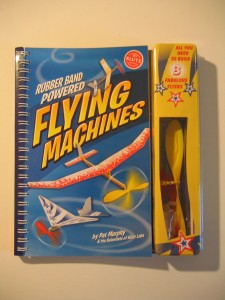
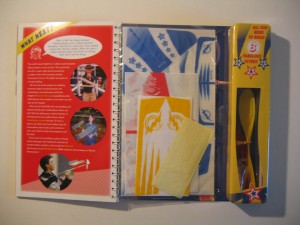
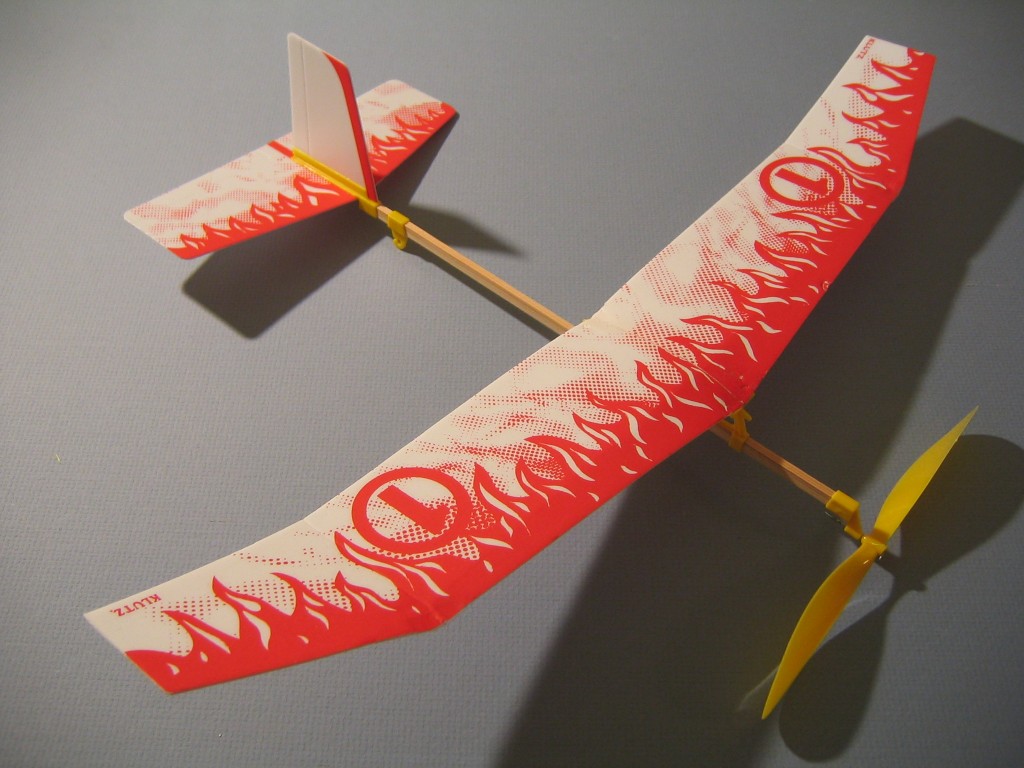
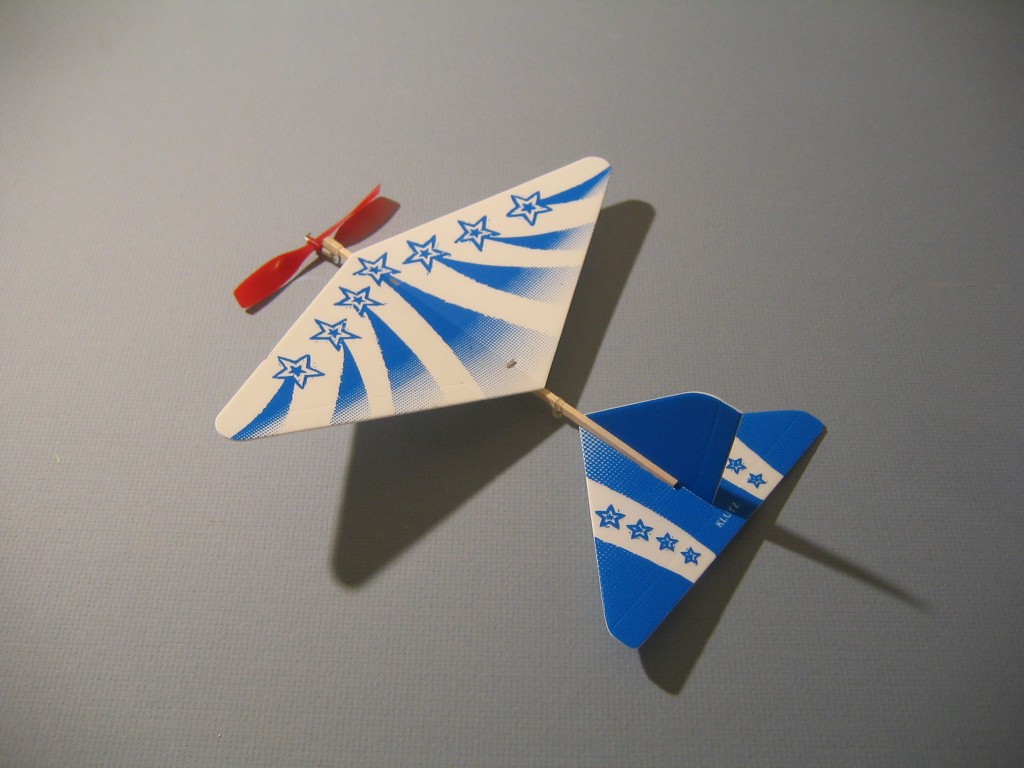
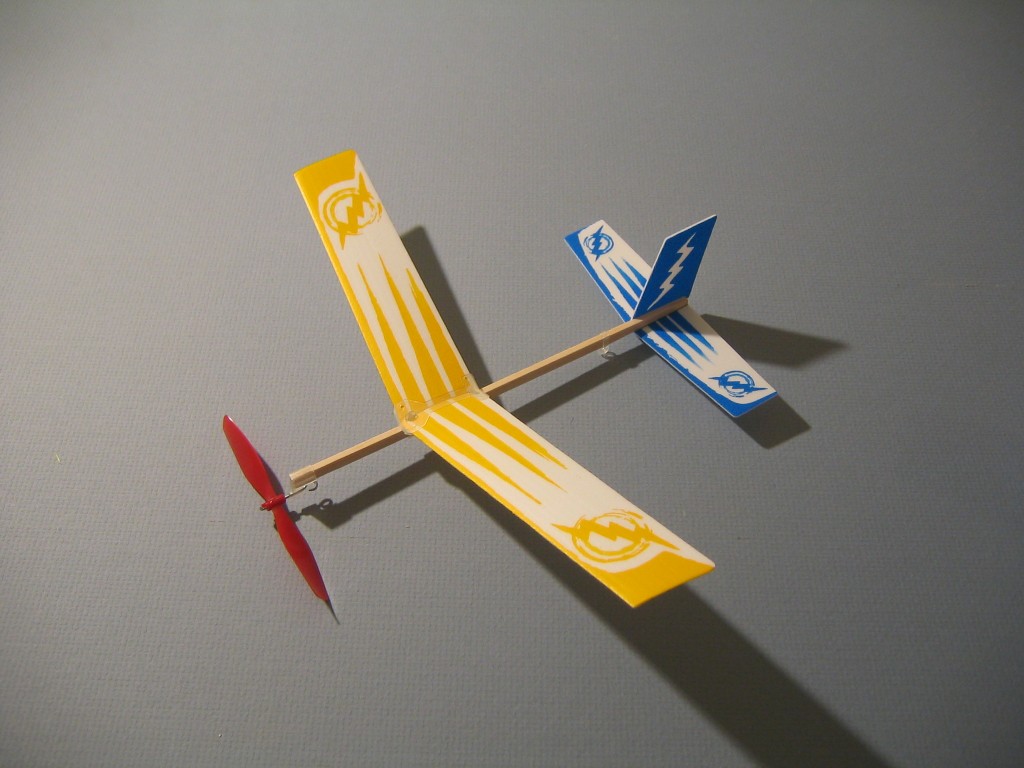
I need two samples of rubber band plane. Would you accept MASTER CARD or MONEYGRAM or WESTERN UNION for payment?
Justus .C
Nigeria
Hi Justice,
We do not sell these planes on EndlessLift. The planes in the book are sold by Amazon.
http://www.amazon.com/Rubber-Powered-Flying-Machines-Klutz/dp/1591747422
The book seems to be out of print at Klutz.
Darcy sells Squirrel kits on http://www.rubber-power.com/get-it.htm
There are many sources of rubber powered planes, many are kits that require assembly. You can also follow the instructions on EndlessLift to build your own planes from raw materials.
Gary
PLEASE GIVE ME A PRICE WERE CAN I BUY ONE
Links are given in the article where you can buy copies online from Klutz, Amazon or Barnes&Noble. They may be available from local bookstores that sell Klutz books. Your local bookstore may be able to order one.
plzzz can i buy it online…………give me the website
Wow, I can’t wait to build my Klutz planes!